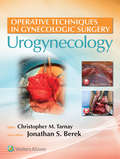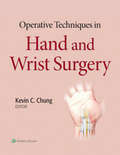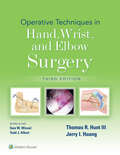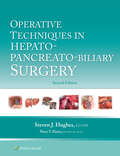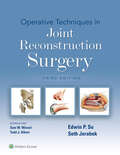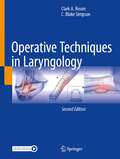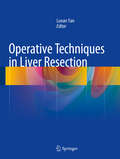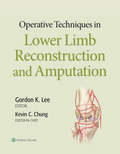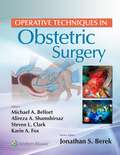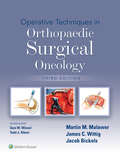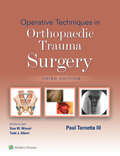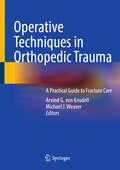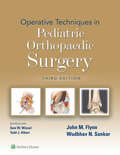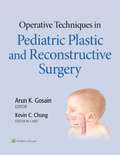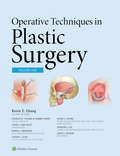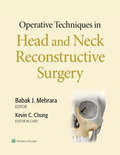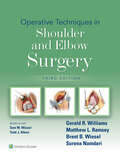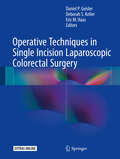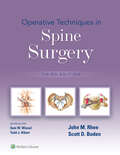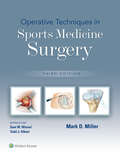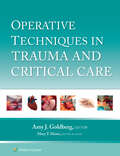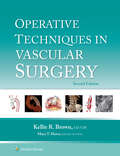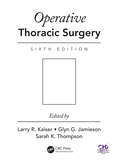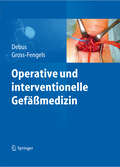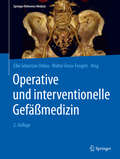- Table View
- List View
Operative Techniques in Gynecologic Surgery: Urogynecology
by Jonathan S. Berek Christopher TarnayPublisher's Note: Products purchased from 3rd Party sellers are not guaranteed by the Publisher for quality, authenticity, or access to any online entitlements included with the product. Third in a new four-volume series, Operative Techniques in Gynecologic Surgery: Urogynecology provides superbly illustrated, authoritative guidance on operative techniques along with a thorough understanding of how to select the best procedure, how to avoid complications, and what outcomes to expect. Easy to follow, up to date, and highly visual, this step-by-step reference covers the most common operations in gynecology and is ideal for residents and physicians in daily practice.
Operative Techniques in Hand and Wrist Surgery
by Kevin ChungPart of the best-selling Operative Techniques series, Operative Techniques in Plastic Surgery provides superbly illustrated, authoritative guidance on operative techniques along with a thorough understanding of how to select the best procedure, how to avoid complications and what outcomes to expect. This stand-alone book offers focused, easy-to-follow coverage of the hand and wrist, all taken directly from the larger text. It covers nearly all plastic surgery operations for these specific areas that are in current use, and is ideal for residents and physicians in daily practice.
Operative Techniques in Hand, Wrist, and Elbow Surgery
by Thomas R. Hunt Jerry I. HuangDerived from Sam W. Wiesel and Todd J. Albert’s four-volume Operative Techniques in Orthopaedic Surgery, this single-volume resource contains a comprehensive, authoritative review of operative techniques in hand, wrist, and elbow surgery. In one convenient place, you’ll find the entire Hand, Wrist, and Elbow section, as well as relevant chapters from the Pediatrics, Shoulder and Elbow, and Sports Medicine sections of Operative Techniques in Orthopaedic Surgery. Superb full-color illustrations and step-by-step explanations help you master surgical techniques, select the best procedure, avoid complications, and anticipate outcomes. Written by global experts from leading institutions, Operative Techniques in Hand, Wrist, and Elbow Surgery, Third Edition, clearly demonstrates how to perform the techniques, making this an essential daily resource for residents, fellows, and practitioners.
Operative Techniques in Hepato-Pancreato-Biliary Surgery
by Mary T. Hawn Steven J. HughesWith an emphasis on the “hows and whys” of contemporary surgery, Operative Techniques in Hepato-Pancreato-Biliary Surgery, Second Edition, features concise, bulleted text, full-color illustrations, and intraoperative photographs to clarify exactly what to look for and how to proceed. Drawn from the larger Operative Techniques in Surgery, Second Edition, this concise, stand-alone surgical atlas, overseen by editor-in-chief Mary T. Hawn and meticulously edited by Dr. Steven J. Hughes, focuses on the steps of each technique, rapidly directing you to the information you need to choose the right approach for each patient, perform it successfully, and achieve the best possible results.
Operative Techniques in Joint Reconstruction Surgery
by Edwin Su Seth JerabekDerived from Sam W. Wiesel and Todd J. Albert’s four-volume Operative Techniques in Orthopaedic Surgery, this single-volume resource contains a comprehensive, authoritative review of a full range of joint reconstruction surgical procedures. In one convenient place, you’ll find the entire Adult Reconstruction section, as well as relevant chapters from the Trauma section of Operative Techniques in Orthopaedic Surgery. Superb full-color illustrations and step-by-step explanations help you master surgical techniques, select the best procedure, avoid complications, and anticipate outcomes. Written by global experts from leading institutions, Operative Techniques in Joint Reconstruction Surgery, Third Edition, clearly demonstrates how to perform the techniques, making this an essential daily resource for residents, fellows, and practitioners.
Operative Techniques in Laryngology
by Clark A. Rosen C. Blake SimpsonThis book provides the laryngeal surgeon with essential background information on laryngological disorders, step-by-step surgical information, and key pearls and pitfalls for laryngeal surgery. The field of laryngeal surgery for voice, swallowing, and airway pathologic conditions has dramatically changed over the last 20 years, and the impetus for this book was to reflect these major paradigm shifts and bring together in one place the essential information on the rapidly growing and changing field of laryngeal surgery. Introductory chapters provide a foundation for the diagnosis and preoperative management of laryngeal pathological conditions. These are followed by the procedural chapters, which encompass a wide range of laryngeal procedures. They have been organized around the broad categories of phonomicrosurgery, awake laryngeal surgery, laryngeal framework surgery, and open airway reconstruction. Each procedural chapter is brief, consisting of five to ten pages, and presents progressive instructions for different laryngeal surgical approaches. The individual steps of the procedure are clearly demonstrated through a series of high-quality intraoperative photos and schematic illustrations. In addition, key aspects of certain procedures are accompanied by a short video. All pertinent information regarding equipment, instrumentation, post-operative care, and possible complications associated with the surgical approach is summarized in bullet format at the end of each chapter. Most of the laryngeal procedures feature an expert commentator who has provided unique insights on important steps and different approaches to the described surgical procedure to provide the reader a variety of perspectives. Operative Techniques in Laryngology is aimed at general otolaryngologists, residents, laryngology fellows, and laryngologists. The emergence and growth of laryngology as a sub-specialty of otolaryngology has established this field as an important partof general otolaryngology training.
Operative Techniques in Liver Resection
by Lunan YanThis book presents the latest knowledge in liver resection. It includes preoperative assessment, hepatic vascular occlusion, live parenchyma transection, various liver resection techniques, liver transplantation, ex situ ex vivo resection, auto-transplantation, laparoscopic liver resection and outcome of liver resection. It describes 21 resection techniques in the same style. Each chapter is built around a series of descriptive photographs and illustrations, which are explained in detail in the text. At the end of each section there are key points that are critical for surgeons performing liver resections. The authors share their extensive experience of liver resections. This book will help practitioners perform safe and expeditious resections and reduce postoperative liver failure. Hepato-bilio pancreatic surgeons, hepatologists, radiologists, clinicians and researchers who are interested in liver surgery will find this book an invaluable guide.
Operative Techniques in Lower Limb Reconstruction and Amputation
by Gordon LeePart of the best-selling Operative Techniques series, Operative Techniques in Plastic Surgery provides superbly illustrated, authoritative guidance on operative techniques along with a thorough understanding of how to select the best procedure, how to avoid complications and what outcomes to expect. This stand-alone book offers focused, easy-to-follow coverage of lower limb reconstruction and amputation, all taken directly from the larger text. It covers nearly all plastic surgery operations for these specific areas that are in current use, and is ideal for residents and physicians in daily practice.
Operative Techniques in Obstetric Surgery
by Steven Clark Michael Belfort Alireza Abdollah Shamshirsaz Karin FoxThe fifth volume in Dr. Jonathan Berek’s bestselling series, Operative Techniques in Obstetric Surgery provides superbly illustrated, authoritative guidance on operative techniques along with a thorough understanding of how to select the best procedure, how to avoid complications, and what outcomes to expect. Easy to follow, up to date, and highly visual, this step-by-step reference edited by Drs. Michael A. Belfort, Alireza A. Shamshirsaz, Steven L. Clark, and Karin A. Fox covers the most common operations in obstetrics and is ideal for residents and physicians in daily practice. Succinct text, bulleted points, and quick-reference tables allow you to review information quickly and understand best practices and potential problems for each procedure. Hundreds of full-color intraoperative photographs and drawings, as well as more than 20 high-quality videos, capture procedures step by step and help you immediately apply your knowledge. Each clinical problem is discussed in the same templated format: general principles, anatomy and differential diagnosis, imaging and other diagnostics, preoperative planning, surgical management, procedures and techniques, pearls and pitfalls, postoperative care, outcomes, and complications. Coverage includes Cesarean delivery, management of postpartum hemorrhage including hysterectomy for placenta accreta spectrum, operative vaginal delivery and repair of lacerations, obstetric fistula repair, and more. Perfect for a quick preoperative review of the steps of a procedure. Volume editors and contributors are thought leaders in their respective subspecialties and are known for their surgical expertise. Enrich Your eBook Reading Experience Read directly on your preferred device(s), such as computer, tablet, or smartphone. Easily convert to audiobook, powering your content with natural language text-to-speech.
Operative Techniques in Orthopaedic Surgical Oncology
by Martin M. MalawarDerived from Sam W. Wiesel and Todd J. Albert’s four-volume Operative Techniques in Orthopaedic Surgery, this single-volume resource contains a comprehensive, authoritative review of operative techniques in surgical oncology surgery in one convenient place. Superb full-color illustrations and step-by-step explanations help you master surgical techniques, select the best procedure, avoid complications, and anticipate outcomes. Written by global experts from leading institutions, Operative Techniques in Orthopaedic Surgical Oncology Surgery, Third Edition, clearly demonstrates how to perform the techniques, making this an essential daily resource for residents, fellows, and practitioners.
Operative Techniques in Orthopaedic Trauma Surgery
by Paul Tornetta IIIDerived from Sam W. Wiesel and Todd J. Albert’s four-volume Operative Techniques in Orthopaedic Surgery, this single-volume resource contains a comprehensive, authoritative review of operative techniques in trauma surgery. In one convenient place, you’ll find the entire Trauma section, as well as relevant chapters from the Hand, Wrist, and Forearm; Oncology; Shoulder and Elbow; and Sports Medicine sections of Operative Techniques in Orthopaedic Surgery. Superb full-color illustrations and step-by-step explanations help you master surgical techniques, select the best procedure, avoid complications, and anticipate outcomes. Written by global experts from leading institutions, Operative Techniques in Orthopaedic Trauma Surgery, Third Edition, clearly demonstrates how to perform the techniques, making this an essential daily resource for residents, fellows, and practitioners.
Operative Techniques in Orthopedic Trauma: A Practical Guide to Fracture Care
by Arvind G. von Keudell Michael J. WeaverThis current textbook provides residents, fellows, and surgeons with an interest in fracture care with the key aspects of, and considerations for, common orthopedic trauma cases. Divided into thematic sections and arranged anatomically, each procedure is described in detail, focusing on patient positioning and the exact steps required to complete each procedure, including traumatic fracture management, external fixation techniques and periprosthetic fractures. To supplement the written step-by-step descriptions, plentiful radiography and intraoperative photos are included to further explain and demonstrate critical or complex steps. Additionally, practical tips by the Harvard orthopedic faculty, and tricks that they have learned over their lifetimes in this field and by treating large numbers of patients, are highlighted. Often, the education of orthopedic surgery residents is based upon the trust and confidence level that develops between an orthopedic attending and his or her resident. Provided with crucial information for a surgical procedure as well as background information, the level of trust and thereby education should increase exponentially. Junior or senior residents and even consultants frequently refer to handbooks prior to surgically treating patients, which provide easily accessible, concise information. Only a few books exist that detail the steps that meticulously describe surgical tips and tricks for orthopedic trauma cases. While geared mainly toward residents, attendings and senior medical students in orthopedics and orthopedic traumatology, Operative Techniques in Orthopedic Trauma is a valuable resource for allied health professionals, including NPs and PAs.
Operative Techniques in Pediatric Orthopaedic Surgery
by John FlynnDerived from Sam W. Wiesel and Todd J. Albert’s four-volume Operative Techniques in Orthopaedic Surgery, this single-volume resource contains a comprehensive, authoritative review of operative techniques in pediatric orthopaedic surgery. In one convenient place, you’ll find the entire Pediatrics section, as well as relevant chapters from the Adult Reconstruction; Foot and Ankle; Hand, Wrist, and Forearm; Oncology; Pelvis and Lower Extremity Trauma; Shoulder and Elbow; Spine; and Sports Medicine sections of Operative Techniques in Orthopaedic Surgery. Superb full-color illustrations and step-by-step explanations help you master surgical techniques, select the best procedure, avoid complications, and anticipate outcomes. Written by global experts from leading institutions, Operative Techniques in Pediatric Orthopaedic Surgery, Third Edition, clearly demonstrates how to perform the techniques, making this an essential daily resource for residents, fellows, and practitioners.
Operative Techniques in Pediatric Plastic and Reconstructive Surgery
by Arun GosainPart of the best-selling Operative Techniques series, Operative Techniques in Plastic Surgery provides superbly illustrated, authoritative guidance on operative techniques along with a thorough understanding of how to select the best procedure, how to avoid complications and what outcomes to expect. This stand-alone book offers focused, easy-to-follow coverage of pediatricplastic and reconstructive surgery, all taken directly from the larger text. It covers nearly all plastic surgery operations for children that are in current use, and is ideal for residents and physicians in daily practice.
Operative Techniques in Plastic Surgery
by Kevin ChungPublisher's Note: Products purchased from 3rd Party sellers are not guaranteed by the Publisher for quality, authenticity, or access to any online entitlements included with the product. A new addition to the best-selling Operative Techniques series, Operative Techniques in Plastic Surgery provides superbly illustrated, authoritative guidance on operative techniques along with a thorough understanding of how to select the best procedure, how to avoid complications, and what outcomes to expect. Easy to follow, up to date, and highly visual, this step-by-step reference covers nearly all operations in current use in plastic surgery, and is ideal for residents and physicians in daily practice.
Operative Techniques in Plastic Surgery: Head and Neck Reconstruction
by Babak MehraraPart of the best-selling Operative Techniques series, Operative Techniques in Plastic Surgery provides superbly illustrated, authoritative guidance on operative techniques along with a thorough understanding of how to select the best procedure, how to avoid complications and what outcomes to expect. This stand-alone book offers focused, easy-to-follow coverage of head and neck reconstructive surgery, all taken directly from the larger text. It covers nearly all plastic surgery operations for these specific areas that are in current use, and is ideal for residents and physicians in daily practice.
Operative Techniques in Shoulder and Elbow Surgery
by Surena Namdari Gerald R. Williams Matthew L. Ramsey Brent B. WieselDerived from Sam W. Wiesel and Todd J. Albert’s four-volume Operative Techniques in Orthopaedic Surgery, this single-volume resource contains a comprehensive, authoritative review of operative techniques in shoulder and elbow surgery. In one convenient place, you’ll find the entire Shoulder and Elbow section, as well as relevant chapters from the Hand, Wrist, and Forearm and Sports Medicine sections of Operative Techniques in Orthopaedic Surgery. Superb full-color illustrations and step-by-step explanations help you master surgical techniques, select the best procedure, avoid complications, and anticipate outcomes. Written by global experts from leading institutions, Operative Techniques in Shoulder and Elbow Surgery, Third Edition, clearly demonstrates how to perform the techniques, making this an essential daily resource for residents, fellows, and practitioners.
Operative Techniques in Single Incision Laparoscopic Colorectal Surgery
by Daniel P. Geisler Deborah S. Keller Eric M. HaasThe goal of this text is to expand one's practice of minimally invasive colorectal surgery by implementation of various advanced reduced port and single techniques. The authors present a comprehensive operative technique text to teach and implement single incision and reduced port laparoscopic colorectal surgery best practices into clinical practice. The text is divided into three main sections: perioperative considerations; focused operative techniques, tips and tricks; and step-by-step details of common colorectal procedures. Each case is paired with intraoperative photos and video accompaniment to facilitate understanding the technique, reproducing the steps, and implementing single incision laparoscopic colorectal surgery. The extensive illustrations and links to video make this a truly interactive text. With the aid of this text, surgeon experienced in laparoscopy, as well as those looking to expand their minimally invasive arsenal will be able to successfully incorporate single incision laparoscopic techniques into practice
Operative Techniques in Spine Surgery
by John Rhee Scott BodenDerived from Sam W. Wiesel and Todd J. Albert’s four-volume Operative Techniques in Orthopaedic Surgery, this single-volume resource contains a comprehensive, authoritative review of operative techniques in spine surgery. In one convenient place, you’ll find the entire Spine section, as well as relevant chapters from the Oncology and Pediatrics sections of Operative Techniques in Orthopaedic Surgery. Superb full-color illustrations and step-by-step explanations help you master surgical techniques, select the best procedure, avoid complications, and anticipate outcomes. Written by global experts from leading institutions, Operative Techniques in Spine Surgery, Third Edition, clearly demonstrates how to perform the techniques, making this an essential daily resource for residents, fellows, and practitioners.
Operative Techniques in Sports Medicine Surgery
by Mark D. MillerDerived from Sam W. Wiesel and Todd J. Albert’s four-volume Operative Techniques in Orthopaedic Surgery, this single-volume resource contains a comprehensive, authoritative review of operative techniques in sports medicine surgery. In one convenient place, you’ll find the entire Sports Medicine section, as well as relevant chapters from the Adult Reconstruction; Foot and Ankle; Pediatrics; Shoulder and Elbow; and Trauma sections of Operative Techniques in Orthopaedic Surgery. Superb full-color illustrations and step-by-step explanations help you master surgical techniques, select the best procedure, avoid complications, and anticipate outcomes. Written by global experts from leading institutions, Operative Techniques in Sports Medicine Surgery, Third Edition, clearly demonstrates how to perform the techniques, making this an essential daily resource for residents, fellows, and practitioners.
Operative Techniques in Trauma and Critical Care
by Mary T. Hawn Amy J. GoldbergWith an emphasis on the “hows and whys” of contemporary surgery, Operative Techniques in Trauma and Critical Care features concise, bulleted text, full-color illustrations, and intraoperative photographs to clarify exactly what to look for and how to proceed. Drawn from the larger Operative Techniques in Surgery, Second Edition, this newly stand-alone surgical atlas, overseen by editor-in-chief Mary T. Hawn and meticulously edited by Dr. Amy J. Goldberg, focuses on the steps of each technique, rapidly directing you to the information you need to choose the right approach for each patient, perform it successfully, and achieve the best possible results.
Operative Techniques in Vascular Surgery
by Kellie R. Brown Mary T. HawnWith an emphasis on the “hows and whys” of contemporary surgery,Operative Techniques in Vascular Surgery, Second Edition, features concise, bulleted text, full-color illustrations, and intraoperative photographs to clarify exactly what to look for and how to proceed. Drawn from the larger Operative Techniques in Surgery, Second Edition, this concise, stand-alone surgical atlas, overseen by editor-in-chief Mary T. Hawn and meticulously edited by Dr. Kellie R. Brown, focuses on the steps of each technique, rapidly directing you to the information you need to choose the right approach for each patient, perform it successfully, and achieve the best possible results.
Operative Thoracic Surgery
by Larry R. Kaiser Glyn Jamieson Sarah K. ThompsonOver a decade after the last edition, Operative Thoracic Surgery, Sixth Edition has been thoroughly revised and updated by a team of prestigious international contributors. Particular emphasis is given to new and emerging techniques, particularly minimally invasive procedures, ensuring that the book remains an essential resource for surgeons in training, residents and fellows in thoracic and esophageal surgery, and fully qualified practitioners needing a definitive reference. Additional text describes the principles and justification of choosing each procedure, pre-operative assessment and preparation, post-operative care and outcomes.
Operative und interventionelle Gefäßmedizin
by Walter Gross-Fengels Eike Sebastian DebusEin offen operatives oder interventionelles Vorgehen ist bei vielen Gefäßerkrankungen die Therapie der Wahl. Mit neu entwickelten Techniken verändern sich auch die Therapieindikationen. Aktuelles und differenziertes Praxiswissen bietet dieses Buch, zu dem zahlreiche Experten mit ihren speziellen Kenntnissen und Erfahrungen beigetragen haben. Es wendet sich ebenso an Ärzte in Weiterbildung zum Gefäßchirurgen, die ihre Facharztprüfung vorbereiten, wie als Nachschlagewerk an alle Gefäßchirurgen, interventionell tätigen Radiologen und Internisten.
Operative und interventionelle Gefäßmedizin (Springer Reference Medizin)
by Walter Gross-Fengels Eike Sebastian DebusDas klinische Wissen zu den Erkrankungen der Gefäße und zur invasiven Gefäßtherapie ist umfassend und detailliert in diesem Buch zusammengefasst - eine unerschöpfliche Informationsquelle für jeden operativ, interventionell oder konservativ tätigen Gefäßspezialisten!Der aktuelle Kenntnisstand zu den physiologischen und pathophysiologischen Grundlagen ist ebenso dargestellt wie die modernen diagnostischen und therapeutischen Verfahren. Den Schwerpunkt bilden die Kapitel, in denen alle systemischen und regionalen Erkrankungen der Gefäße ausführlich beschrieben werden. Auch seltene Erkrankungen und Konstellationen sind berücksichtigt. Für jede Indikation werden die Therapieoptionen sorgfältig abgewogen und konkrete Empfehlungen zum praktischen operativen und interventionellen Vorgehen gegeben. In der 2. Auflage wurden die Kapitel durchweg aktualisiert und zum Teil komplett neu verfasst:· neben Experten aus dem deutschen Sprachraum wurden für einzelne Themen auch internationale Spezialisten als Autoren gewonnen.· zusätzliche Kapitel zu diagnostischen Verfahren (wie PET/CT), therapeutischen Methoden (wie allogene und xenogene Materialien) und klinischen Fragestellungen (wie Portanlage und PICC, Damage Control Surgery bei Gefäßverletzungen und intestinale Aneurysmen) wurden ergänzt.Parallel zur gedruckten Ausgabe erscheint erstmals eine online-Version, die als Live Reference-Ausgabe kontinuierlich aktualisiert wird.
